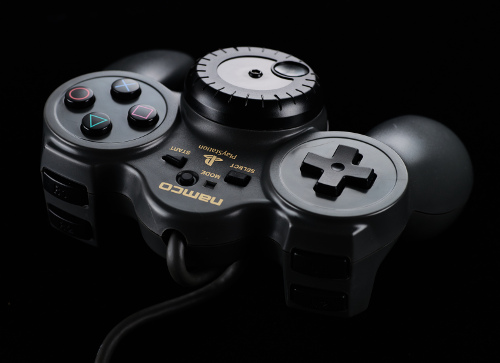Games
Review: Namco’s JogCon for Playstation
This is a re-posted review from a site I shut down in 2009.
The Namco JogCon is unique among console controllers. It’s the first force-feedback controller for any home game system, and it’s still the only hand-held one. While several controllers offered ‘force feedback’ in the form of simple vibration, the JogCon was the first to offer real counter-active force to the player, fighting against the player’s inputs to simulate real steering effects.
Namco released it in 1998 along with Ridge Racer 4, and it was sold both separately and as a bundle with the game. Since its release only one other real force-feedback peripheral has been released for consoles: Logitech’s series of racing wheels for Xbox and Playstation.

No doubt Namco thought it would be a great idea to release this to make their acclaimed Ridge Racer 4 even better, but there’s no chance they succeeded. The JogCon is not a good controller, by any measure, and its place in history is guaranteed only by the half-assed feedback it offers. None of its failures are particularly serious, but there are many of them, and the combined effect ruins any chance the controller had of being enjoyed.
The flaws start from the beginning: The Playstation does not offer a significant amount of power through the controller port. This would prevent any right-minded people from pursuing force feedback, ’cause without power your feedback motors are weak, and the little handheld JogCon’s motors are weak indeed.
Undaunted by this flawed initial premise, Namco compensated by putting the disc/wheel in the middle of the pad, making it awkward to reach and manipulate. The upside of this contortionate arrangement is the player cannot exert enough force to overcome the weak motors.
As if that weren’t enough, they built it to a budget. It looks and feels cheap, with untextured flat surfaces and a steering disc/wheel that’s sloppy to turn and wobbly on its axis.

The wheel is really too flexible. No doubt if it was made of magnesium alloy they could build it to withstand serious stresses, but no, it’s entirely plastic, and the disc/wheel flexes quite a lot. This means two things to the player: It feels cheap, and it doesn’t fucking work. What little force the motor applies to the wheel makes it harder for the player to push, so the player pushes harder, and because the disc/wheel flexes so much, not even one lap can be played before the wheel has flexed against the controller surface and locked up solid. The motor doesn’t matter anymore, the player’s pushed hard enough (and that’s not very hard!) that it won’t turn at all.
Not only that, but the indent on the wheel itself, ostensibly designed for a thumb to settle in, has hard sharp edges, and it doesn’t take long to really hurt yourself. Perhaps this was the point: if it hurts to use, the player’s not likely to push very hard, the motor won’t be overridden and the disk won’t flex and bind. They might as well have glued several piranhas to the controller if they really didn’t want anyone to use it.
So you’ve got a dumb idea implemented cheaply and to no one’s surprise it’s fatally flawed and painful to use. No doubt there are some who could exhibit the required restraint, and could play with the JogCon happily, but I’ve never met one of these double-jointed weak-but calloused thumb-sportin’ sedated folks, and I doubt many people have.
As a novelty it’s worth maybe five bucks, but as a serious racing implement you’re better off just slamming your thumb in the door before playing with your regular pad.
—-
Compatibility: It’s not wheel-compatible, so unlike the NeGCon it can’t be used for most Playstation racing games. It does work with Ridge Racer 4 and the PS2’s Ridge Racer V, but beyond that you’d best assume it doesn’t work.
Technical: The wheel is free-spinning, and is connected to the motor by a series of gears. The slack in these plastic gears contributes to the overall cheap feel, as the disc rotates a bit before engaging.
The view inside is, at first, no different from any normal Playstation controller: A green PCB, some wires, etc. It’s the other side that is interesting…

In the picture below, the wheel (top) is shown upside down. When inverted and placed onto the gear assembly, the inside ring of teeth engage with the outermost white gear. The notches along the wheel’s perimeter pass through the little optical sensor on the right of the gear assembly, in the same way old mice, trackballs and old arcade spinners work.

--NFG
[ Nov 14 2022 ]
| Next Post | Navigation | Previous Post |
|---|



Name:
Email:
Website: